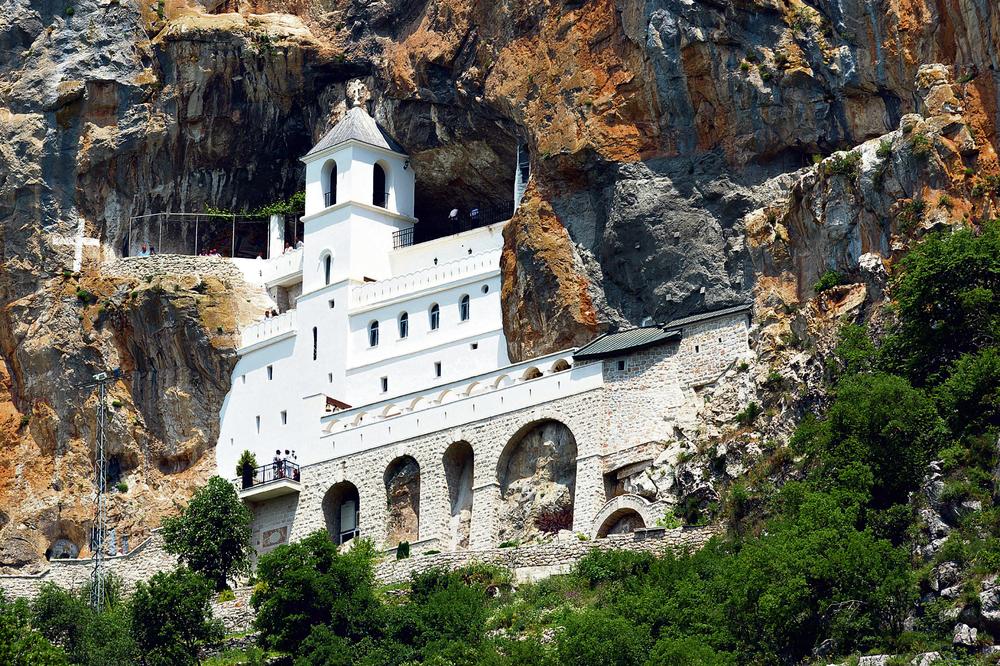Religious tourism
The most important objects of the Orthodox religion
Ostrog monastery
Great respect for St Vasilije made monastery Ostrog one of the most visited sanctuaries in Slovenian south. Both local and foreign travelers are impressed with Montenegrin sacral buildings. Monasteries have always been important pilgrimage sites, their relics attracted people from all over the world. Monastery Ostrog is the greatest Montenegrin Orthodox sacred place, which is built into rocks and has for centuries conveyed messages of peace and love between heaven and earth. From that place you can rest your eyes on Bjelopavlic plain and the River Zeta. The founder of the monastery is archbishop Vasilije Jovanovic. He first came to the monastery in 1656, although some older records from 1600 state the name of prior Isaia as the founder, that the Turks killed and burned on Planicica. Monks inhabited the area which is referred to as Upper monastery (Gornji manastir). It is located 900m above the sea level and it rests on a high rock, with a part of it hidden in natural rock cavity. It consists of two cave-like churches/monasteries, and they represent monumental value of spiritual culture.
The Lower monastery (Donji manastir) is devoted to the Ascension of Holy mother of God, while the Upper one (Gornji) to the Cross of Honour. The walls were painted in 1667. St Vasilije of Ostrog died on 12th May 1671 and his relics rest in peace in coffin in Lower monastery (Donji manastir). Beautiful frescoes on their walls probably originate from 17th century. The Lower monastery was built on the site of former village called Kosjerici, 800m above the sea level. At first there was St. Georgy church, but tectonic movements have destabilized the ground where the church was built and it was many times renovated. In 1827 not far away from where today’s church stands with the help of archimandrite Josif Pavicevic and donations that were made by religious christians was built a new church. The church is consecreted to the Holy Trinity.
According to the information obtained from the custos, Pero Radonjic, from the Homeland Museum in Danilovgrad, people started to celebrate st Vasilije on the day of his death. That’s 29th April or 12th May (discrepancies are present due to two different calendars). Ostrog monastery also has relics sacred hands of a boy named Stanko from Podvraca village, who was killed by the Turks in 1714 when the army under the comand of vizier Cuprilic pillaged this area. The body of the Saint was few times transferred and removed before the foray of the Turkish army. When Numan pasa Cuprilic in 1714. attachted Montenegro, it was remembered that monks buried the relics on the banks of the River Zeta near village Vrazegrnci. The river flooded the area. It is a real miracle that after a year undamaged relics were again dug up and returned to Ostrog. The saint was transferred three times before the Turkish attacks in 1852, 1877 and 1942.

Imediately after the establishment of the cult of St Vasilie the pilgrimage from far away places started. Records of that can be found in an old book called “General leaf“ (Opšti list) from 18th century. Sreten Petkovic a famous scientist wrote: “When the relics were all found, they were transferred to the monastery Ostrog and then began the reunion of believers from nearby areas and St Vasilie became one of the most celebrated saints“. People started to make group pilgrimage. People from Boka were coming to the monastery through Krivosije, Grahovo and Niksic and coming back over Orja luka passing through villages Zagarace, Velestovo, Cevo, Bjelice, Ceklice and Njegusi. Right after Vasilije was proclaimed a saint, common people parliaments (called sabori) were established in Ostrog. They were held on Holy Trinity Day, st Peter’s Day, st Ilija’s Day and on St Vasilije’s day. Famous travelers from our and foreign countries wrote their great impressions about the parliaments, especially about those that were held on holidays such as the Spirits and the Holy Trinity day. An english writer Denigon wrote in 1865. that Ostrog gathers about 20,000 believers when the Spirits are celebrated. Great respect for the saint of Ostrog made this monastery one of the most visited sanctuaries in Slovenian south. Ostrog had an important role at keeping faith and national thought, particulary during the times of slavery. The saint himself left in heredity that tradition. He welcomed troop leaders. Until 1853 the monastery had kept a gun, called „šiba“ that belonged to the national hero Bajo Pivljanin. In the first half of 19th century, the monastery was a center of movement and fight against the Turks. In Ostrog people could also learn how to write. There is a written note from 1712. which informs us about a school which prior Josif Pavicevic opened in 1820.
Travel writers were impressed with monastery and there are a lot of testimonies about that. That’s how the Napoleon’s colonel and French commandant Viala de Somier payed a visit to it in 1810. Montenegro and he wrote a book about it and published it in Paris 10 years later. It is entitled „Historical and political way to Montenegro“. In his book, more pages were dedicated to the monastery Ostrog.

